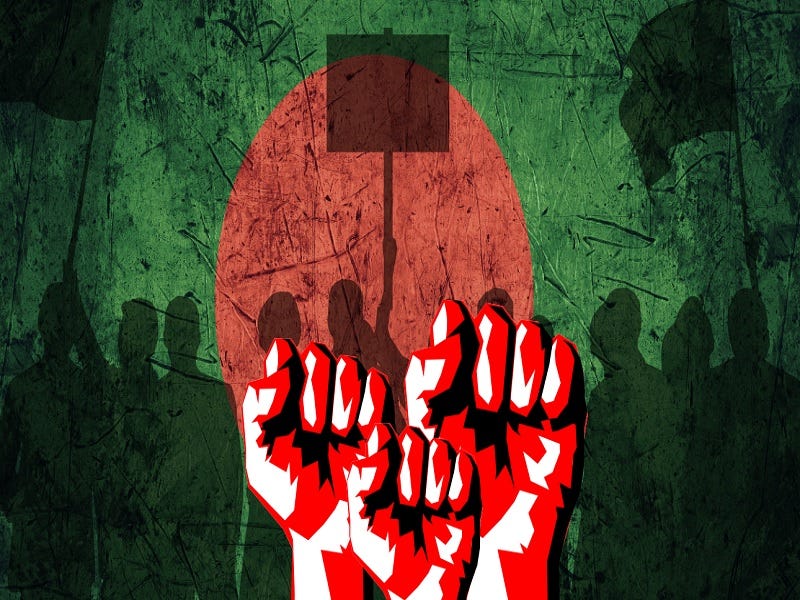While the optics of what transpired resemble a Color Revolution to the untrained observer, the fact of the matter is that these were homegrown riots triggered by long-brewing discontent with a decades-old policy, though the outcome can still be exploited by external players.
The Associated Press reported on Wednesday that “Bangladesh crawls back to normalcy after violent clashes that killed nearly 200 people” over student-led rioters’ demands that the state slash its prior 30% quota reserving government jobs for relatives of those who fought in their War of Independence. The Supreme Court subsequently cut it to just 5%, which helped to restore a semblance of order in parallel with the military-imposed curfew that was earlier imposed and is now gradually being relaxed.
Here are some background briefings about everything that preceded the latest unrest:
* 16 April 2023: “Why’s The US Scheming To Carry Out Regime Change In Bangladesh?”
* 26 November 2023: “Russia Warned That The US Might Orchestrate A Color Revolution In Bangladesh”
* 10 January 2024: “The Outcome Of The Bangladeshi & Bhutanese Elections Gives India Strategic Breathing Space”
* 28 January 2024: “The Bangladeshi Opposition’s New Narrative Is Meant To Maximally Appeal To The West”
* 27 May 2024: “Bangladesh Warned About A Western Plot To Carve Out A Christian Proxy State In The Region”
They’ll now be summarized for the reader’s convenience and then placed into the latest context.
In brief, the US is increasingly souring on India and thus sees Bangladesh as a weak point to destabilize as punishment for Delhi’s independent foreign policy, plus Washington is also displeased with Dhaka for refusing to dump Moscow. These factors motivated it to consider organizing a Color Revolution during January’s elections, though this ultimately didn’t unfold. Nevertheless, American-Bangladeshi trust plummeted, and that’s why its leader implied that the US wants to carve a proxy state out of her country.
It might therefore have seemed to some outside observers that the latest unrest was little more than a delayed Color Revolution, but the reality is much more complex. While the opposition definitely played a role in stoking and perpetuating the riots, they largely remained student-led and came to involve other members of the population due to how emotive the issue of government job quotas is to many. This doesn’t excuse the violent means that they employed, but it helps explain why their cause is popular.
Bangladesh’s economy has grown larger than Pakistan’s in recent years, which is all the more impressive since it used to be a part of that country till its War of Independence, yet some segments of society are displeased with the way in which wealth has been distributed and are concerned about workers’ rights. This rising dissent coupled with the trend of underemployment combined to mobilize some already opposition-inclined youth against the government job quota policy.
Although the number of new jobs that are available in this sector each year pales in comparison to the country’s needs, those who obtain them are considered to be set for life, hence why it became so popular to demand that more of them be based on merit instead of familial connections. The opposition then exploited this sentiment to agitate against the ruling party and radicalize some protesters into committing acts of violence.
While the optics of what transpired resemble a Color Revolution to the untrained observer, the fact of the matter is that these were homegrown riots triggered by long-brewing discontent with a decades-old policy, though the outcome can still be exploited by external players. Those that were recently mobilized could be drawn towards the opposition and foreign intelligence-backed “NGOs”, if they aren’t already connected to them already, and thus set the stage for a second round of unrest at a later time.
The ruling party therefore has a serious problem on its hands since young adults’ newfound alignment with the opposition as a result of the latest developments, including what some participants consider to be the disproportionate use of force by the security services, is a trend that won’t be easily reversed. All sorts of other socio-political disruptions might soon materialize as a result of this nexus, each of which could be externally exploited through financing, organizational support, and/or friendly media reports.
That’s already in the process of unfolding too as the protests morph from wanting to reform the former government job quota policy to calling for the Prime Minister to apologize, other ministers to resign, and some members of the security forces to be arrested, among other demands. It’s not hard to see how this could quickly evolve into an explicit call for regime change, more protests to that end, and a terrorist-insurgency campaign by the most radical anti-government forces if the state cracks down even further.
Bangladesh will therefore find itself pressured even more than before in the future, though it’s unclear when the next round will begin, the extent to which external players will involve themselves, and how serious everything will get once that happens. In any case, the authorities must brace themselves for what will inevitably come, including through the cultivation of pro-government civil society forces who could peacefully counteract anti-government ones per the teachings of “Democratic Security” theory.
Bangladesh’s geostrategic importance in the New Cold War balance of power, which is due to its pivotal location at the crossroads of South and Southeast Asia in the northern reaches of the Indian Ocean, means that it’ll forever remain a subject of foreign intrigue. The ruling party’s policy of multi-aligning between China, India, Russia, and the US is pragmatic, but it’s precisely the reason why Washington is meddling in its affairs since it’s responsible for why Bangladesh hasn’t become the US’ “junior partner”.




